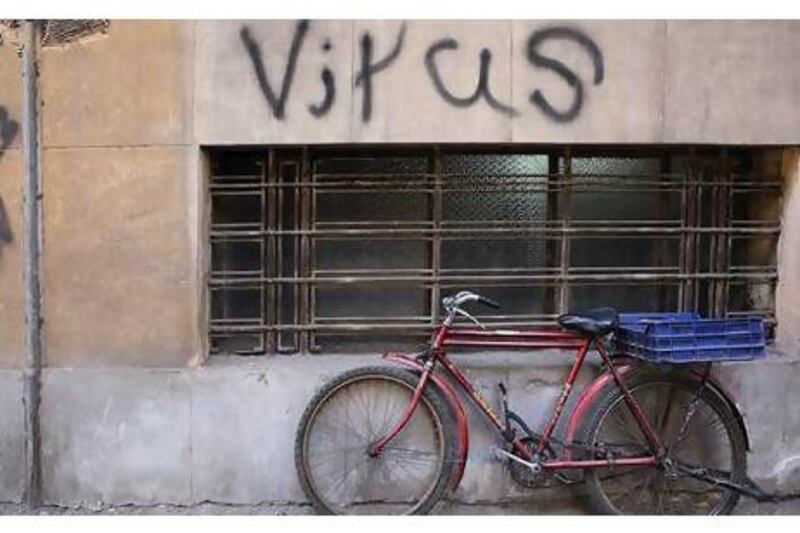The Lebanese photographer Rhea Karam is fascinated with public walls. Whether they bear graffiti, street art or simply the battle scars of civil unrest, she has spent the last five years capturing them on film. Her show at The Pavilion Downtown, Breathing Walls: Egypt is the latest instalment of the series that began in Lebanon in 2007.
What was the original inspiration for Breathing Walls?
I did not go searching for the idea, it came to me naturally as I walked in the streets of Lebanon. I found myself being constantly confronted by slogans, graffiti and political propaganda. I was fascinated by the interaction that was taking place and the messages that were being communicated. Then I realised that public walls were a soapbox for the general public to express themselves in a genuine and unbiased way. I could not remain oblivious to these messages and felt the need to document them as a way to keep an archive of a certain period in time.
Why did you to go to Cairo?
There are several locations I am interested in photographing and Cairo was among them. The revolution that started in 2011 transformed Egypt’s political and urban landscape. The uprising was happening on the streets and the walls were a firsthand witness to this historic transition. I felt it was crucial to document them, especially considering how fast they were changing and how quickly the messages were being erased. It was impossible to document as much as I would have liked to.
Do you consider the project to be developing and breathing along with the walls themselves?
Yes, absolutely. This is an ongoing project that I will continue to pursue throughout the Middle East where important sociopolitical changes are taking place. Breathing in the title represents how these walls live and evolve – as long as they continue to do so I will continue to photograph them.
What is your favourite image from the series and why?
My favourite image constantly changes. Liars is one of my favourites because it shows how even the most fragile medium can communicate the strongest of messages. The image depicts the word liar spelt out with someone’s finger on a dusty display box. It proves the incredible need people have to express their opinion and how creative they become to get their message across.
Do you consider the work you capture to be graffiti, art or simply a snapshot of social commentary?
I consider my work to have both an archival and artistic purpose. Archival by documenting the urban landscape to keep a record of social and political change and artistic by composing the images in such a manner that they can stand alone regardless of the content.
You capture things that people usually simply walk past. Is it your hope that, after seeing your work, people become more observant?
I began photography as a means to capture the beauty I perceived in the familiar. I hope that after viewing my images people can begin to observe beauty where they hadn’t noticed it before.
Where will you go to photograph next?
I would like to photograph the remaining blast walls in Iraq that have reshaped Baghdad into a tangled maze since 2003. They have caused tremendous damage to the city’s infrastructure and are a daily reminder that the country remains divided and in conflict.
Breathing Walls: Egypt runs until August 31
Treasuring the everyday
In Gallery Two of the Pavilion Downtown is a giant image of a palm tree on a white sand beach with azure waters. Look a little closer and you will see this is actually an image of an image; question the artist and you will discover it is a photograph of the wallpaper in her room at university.
Hung from the Moon is Farah Al Qasimi’s first solo show and it is a collection of photographic pieces capturing mundane details of everyday life such as the remnants of a birthday cake, a collection of old perfumes in the family home or a paint-stained sink. Somehow, in these relatively banal images, she has portrayed a sense of memory, identity and sense of belonging. It is a courageous show and reveals a carefully considered thinking.
One of the things I took away from university was how to tirelessly stand by your work, how to do something that you believe in and that you can defend and how to continue to work regardless, says Al Qasimi, 21. I think they instilled this bravery in me.
Al Qasimi, who studied at Yale, is originally from Abu Dhabi but is now living and working in Dubai, and says she sees herself as a fly on the wall and likes to silently observe while at the same time imposing her vision. I find personality and humour in inanimate objects, she says. For a lot of my life I have felt like a kind of observer and I think when art becomes interesting is when you get a sense of what a person’s mind is like and what things they will notice or find funny. To delve deeper into her mind, make sure to visit The Pavilion this summer.
Hung from the Moon runs until August 31
Follow us
[ @LifeNationalUAE ]
And follow us on Facebook for discussions, entertainment, reviews, wellness and news.





